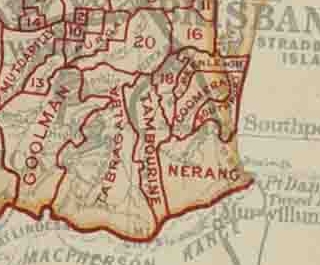c.1876 to 1942


An important note of interest for the beginnings of Tambourine, is that the very centre of the township was originally located on the Yore Property. The town started at the front gate and included a hotel, a hall, saddlery, butchers shop and slaughter yard, the Tambourine Provisional School, and the Council Divisional Office. The first hotel to be established on the property of Michael Yore was built by John Ryan, but was later smashed by the 1887 flood. After the flood, a second hotel was built near the main road on the property beside the hall.
At a Saturday night meeting at the Tambourine Hotel in 1895, the Tambourine Jockey Club was formed on the property of Michael Yore. ‘Ardee’ House was purchased to breed blood horses.
The Tambourine Hall Committee formed in 1920 and at the first official meeting it was proposed to build a new hall in order to accommodate the many dances and activities. The hall’s first bank account was opened in March 1921, and in May 1929, the Tambourine Hall was handed over to the people of Tamborine free of debt for their use. The first Ladies Committee was also officially formed in 1929 to include Mrs EP Walsh, Mrs A Massie, Miss K Siganto and Miss Knight.
The second hotel continued operation until the 1930s when it was moved to near the store in the now centre of town to become the third Hotel of Tambourine. In the 1930s, the third hotel finally burnt down in a suspicious fire after the lease was not to be renewed.
In 1936, the Dean family took over ownership of the Tambourine Post Office and General Store. In 1939, ‘Tambourine’ was officially renamed to ‘Tamborine’, to become the ‘Tamborine Shire Council’. The council offices too were moved into the centre of town, located close to the Tambourine Station. The railway at this stage ran from Plunkett Station (located on the property of Tank Ride) following close to the old Tambourine Logan Village Road (crossing the Albert River) to Tambourine Station (close to where St Patrick’s Catholic Church’s is now located). (Some of the wooden structures/sidings at both of these locations still remain – but you have to look closely!)
In 1940, the Tamborine Hall was damaged by a storm that left the church next door untouched. From 1940 to 1941, preparations were made to pull down the hall and re-erect it on the new site (where the current Rural Fire Station is located). On 26 April 1941, the new Hall was officially opened and renamed to Tamborine Memorial Hall.
At a Tamborine Shire Council meeting on 10 November 1941 it was decided by seven votes to three in favour of removing the Shire Office from Tamborine to Canungra. Clr. Geissmann asked that the notice be rescinded but was not accepted.
In July 1942, during World War II, the 32nd Infantry Division of the American Army established a jungle warfare training camp in the Yarrabilba area called Camp Tamborine, creating the busiest period for traffic on the railway line. In 1942, the Australian Defence Canteen Service took possession of Tamborine Memorial Hall for use as a major storage facility.
Camp Tamborine was later called Camp Cable in honour of Sergeant Gerald O’Cable, one of the 32nd Infantry Division, or Red Arrow Brigade, who was killed during transport along the southern Australian coast when torpedoed by a Japanese submarine. The Australians had camps at Maclean, Jimboomba, Tamborine and Canungra and the Americans at Jimboomba, Tamborine and Beaudesert.
An Army Hospital was built on the south side of the river as well as a Theatre.This was a major camp housing as many as 35,000 soldiers en-route for service in the Pacific War region.
